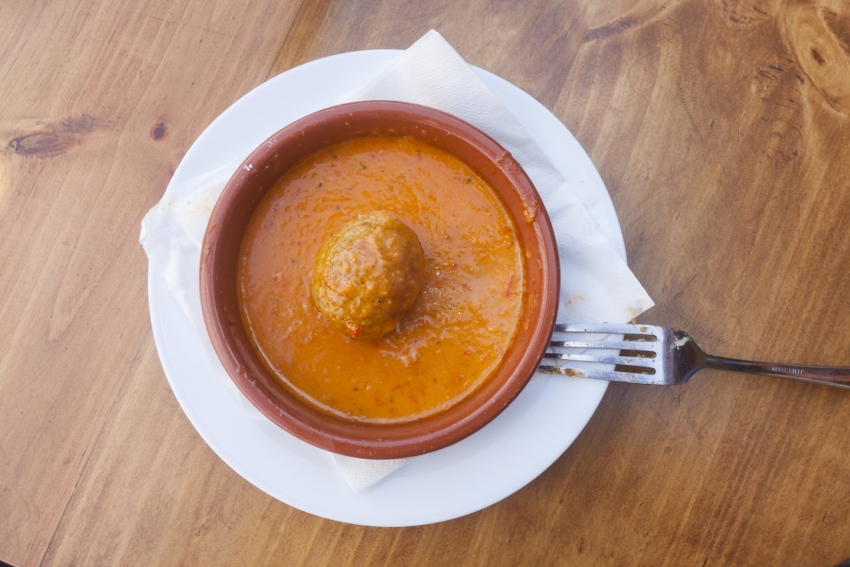What's in a name
Mojo gets its name from 'Molho', the Portuguese word for sauce. Why? Because many of the original settlers in the Canary Islands were from the Portuguese island of Madeira just north of the Canaries. They came south along with sugar cane and, although later absorbed into the Spanish settler population, left traces of their influence in the language, cuisine and architecture of the Canary Islands.
What exactly is mojo
Canarian mojo sauce or dip is made with a base of olive oil, vinegar, sea salt and garlic. Red mojo is flavoured and coloured with pimentón (paprika), chili and cumin while green mojo uses coriander or parsley and green peppers. Mojo is packed with flavour but isn't very spicy unless you get mojo picón; a version of red mojo made with local bird's eye chillies known as 'pimientos de la puta madre'.
Red mojo is traditionally served with small potatoes boiled in salty water until they go wrinkly while green mojo is traditionally served with fish. Tourists often see red and green mojo served along with aioli as a triple dip served with the bread.
Lex says: One of the great things about mojo is that there are as many recipes as there are cooks and none of them taste as good as your gran's version.
Variations of mojo sauce are common in Cuba, Puerto Rico and other Spanish-Caribbean islands. Mojo is also believed to have influenced the sauces, marinades and barbeque of Deep South cuisine in the USA.
Mojo in history
Mojo sauce is a delicious consequence of the Canary Islands' role as a bridge between Europe, Africa and the Americas. It was probably invented in the Canary Islands because this was the first place where all the ingredients came together; chili peppers from South America, pimentón and olive oil from Spain, cumin from North Africa. And let say that the long-lost Guanche cuisine, which developed over 1,500 years before the Spanish arrived in the Canaries, had its influence as well.
The history of green mojo
Green mojo is clearly a variant of Mediterranean green sauce or salsa verde (made with herbs, oil, vinegar and garlic) common from Portugal to Italy. The original recipe is thought to have come to Europe from the Near East with Roman legionaries.
Each country uses a different mix of herbs for their own green sauce; In Portugal, parsley is the main green element; In Italy parsley and capers are combined with onion and anchovies; In France, sauce vert contains tarragon and even sage and parsley. The Germans go wild with Grüne Soße, which contains Northern European green herbs like borage, sorrel, garden cress, chervil, chives, parsley, and salad burnet.
In Mexico, salsa verde contains coriander along with green tomatillos and hot green peppers.
In the Canary Islands, coriander (cilantro) is the main green ingredient, although some people add parsley and even green pepper (although this makes grannies spin in their graves).
The history of red mojo
Red mojo seems to have it's origins in North African or Spanish cuisine (itself heavily influenced by 800 years of Moorish occupation). It may well back to pre-Hispanic times as we know that the island's original Guanche inhabitants were Berbers from North Africa.
Consider how similar red mojo is to the Moroccan marinade called chermoula. It contains olive oil, preserved lemon peel or lemon juice, garlic, cayenne, paprika, cumin, parsley and cilantro.
Pimentón is also a common flavouring in Spanish food and is used to flavour and spice sobrasada sausages and paste.
What about the potatoes?
Red mojo is served on papas arrugadas; little potatoes boiled in sea water until their skin wrinkles up and a fine crust of salt appears. The best potatoes to use are tiny little ones with purple skin and yellow flesh that are called papas negras. They were amongst the first potatoes brought to Europe from America and have disappeared everywhere except the Canaries.
Alex says: If you ever find a menu that translates papas arrugadas as 'wrinkly popes', please steal it for us. It's a mythical mistranslation but we've never seen it.
So that's the history of Canarian mojo sauce. Like all good things, it came out of a blend of cultures and cuisines and found its own home where they all met. To make it, follow our red and green recipes.














